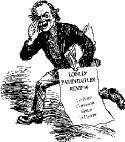
 |
 |

| Saturday, September 07, 2024 |
Miles from the Mainstream |
D.
R. ZUKERMAN, proprietor |
May 5, 2023 -- Please Chairman Jordan, do not give exclusives to The New York Times -- for example, the inside story of the decision by Manhattan District Attorney Alvin Bragg's decision to take the advice of Judge Mary Kay Vyskocil for Mark Pomerantz to appear before the House Judiciary Committee for a deposition. Scoops to the Times only continue to reputation of this propaganda sheet as the country's newspaper of record. Give scoops to an objective outlet -- Lonely Pamphleteer Review, for example. In the Bragg matter, Judge Vyskocil "encouraged" the "parties" to arrive at "a mutually agreeable compromise" on the Pomerantz deposition, and apparently such agreement was reached. It is unclear, however, as to which of the "parties" reached out to make possible the May 12 deposition of anti-Trump attorney Pomerantz. Here is the last paragraph of Judge Vyskocil's opinion, calling for compromise and also stating that she "retain[s] jurisdiction over this dispute". "The parties are encouraged to speak with one another to reach a mutually agreeable compromise regarding how the deposition of Mr. Pomerantz will proceed. This Court will retain jurisdiction over this dispute and any ancillary claims arising out of the inquiry by the Committee relating to the use of federal funds in a manner that may influence the 2024 presidential election. In other words, Bragg may not file successive proceedings under a different index number if and when the Committee in fact issues another subpoena that he finds objectionable or if there are issues with respect to the Pomerantz deposition. The parties are HEREBY ORDERED to file a joint status report within 30 days of the date of this Order." (P. 25)" This is to call to your attention two salient observations in Judge Vyskocil's insightful opinion: her description of much of the filing (from Theodore Boutrous, of Gibson, Dunn and Crutcher, not of the office of the Manhattan d.a.). as "nothing short of a public relations tirade against former President and current presidential candidate Donald Trump." -- and the judge's description of another filing, apparently from attorney Boutrous on behalf of Mr. Bragg, of "sixteen largely irrelevant exhibits, consisting of a hodge-podge of social media postings, news articles, televisions interviews, pleasings from unrelated lawsuits...." In short, it seems fair to understand that Judge Vyskocil, in her opinion upholding your subpoena to Mr. Pomerantz, signaled, in effect, that the argument on behalf of the Manhattan d.a. was, to borrow her description of "a motion to quash a subpoena dressed up as a lawsuit," -- a piece of anti-Trump propaganda pretending to be a legal argument, and, therefore, not suitable in a court of law. |
Indeed, where was the individual in the office of the Manhattan district attorney -- or, indeed, at the law firm of Gibson, Dunn and Crutcher, to tell Mr.. Bragg that his opposition to the House Judiciary Committee's subpoena for the Pomerantz deposition was no more persuasive than an anti-Trump press release from the Democrat National Committee, eagerly dressed up as a Times editorial? Where was the attorney in Bragg's office or at Gibson, Dunn and Crutcher to remind Mr, Bragg that Donald J. Trump is a private citizen, now, but also a former president and, as such, comes under the protection of the federal government pursuant to the Former Presidents Act of 2012, which statute can indeed be amended to protect former presidents from harassment at the hands of local or state officials who are hostile zealots to former president? To give the inside story to The New York Times, of your agreement with the Manhattan d.a. to depose Mr. Pomerantz, would be to reward a propaganda source that encouraged, effectively, Mr. Bragg to file what in retrospect was clearly a frivolous lawsuit against you and your Committee. And by the way, did Gibson, Dunn and Crutcher provide pro bono service for Mr, Bragg, or did it pile up billable hours, to be paid with taxpayer funds? The first 35 pages of the Complaint have little to do with the subpoena at issue and are nothing short of a public relations tirade against former President and current presidential candidate Donald Trump. The same is true of the vast majority of the exhibits accompanying the Boutrous Declaration. (At 5) At heart, the Complaint simply includes two requests for declaratory and injunctive relief directed at the congressional inquiry. The reality is that, as framed, this action is merely a motion to quash a subpoena dressed up as a lawsuit. (At 5) The day before the scheduled hearing, Bragg filed an eleventh hour reply brief, not authorized by the Court’s Scheduling Order given the compressed time frame in which Plaintiff’s motion was brought on. The reply largely rehashes the same arguments made in the moving brief and, for the first time, addresses the Speech or Debate Clause. See Reply Brief [ECF No. 41-1] (“Reply”). The reply brief was accompanied by a supplemental declaration attaching sixteen largely irrelevant exhibits, consisting of a hodge-podge of social media postings, news articles, television interviews, pleadings from unrelated lawsuits, and a transcript from the arraignment in the Trump prosecution. See Exhibits 60–72 to the Second Boutrous Declaration [ECF Nos. 41-2 to 41-5]. (At 7)
|
|
